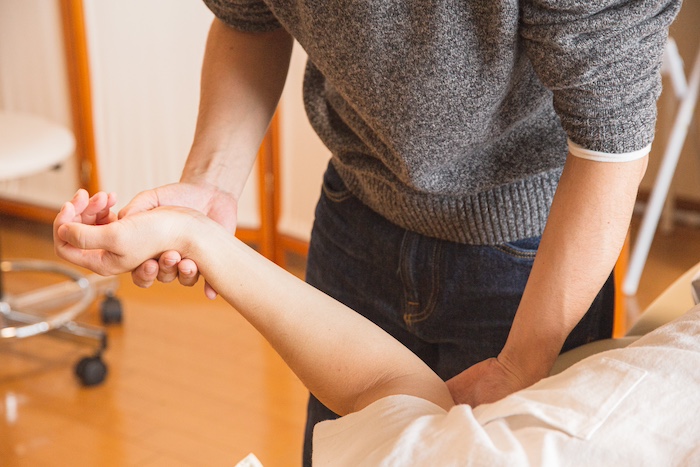
Introduction
The elbow is a critical joint in the upper extremity. Without it, we would not be able to get some of our most basic needs met, such as feeding ourselves, brushing our teeth, or putting a shirt on. It is the link that allows us to bring our hands to our faces or to reach for a shelf to grasp an object. So, when that joint is affected by arthritis, it can be a major problem.
Arthritis in the elbow joint can lead to pain, swelling, and decreased range of motion, as well as decreased functional use of the arm. Therapy for arthritis can be beneficial to address these issues. While some types of arthritis cannot be reversed, some things can be done to manage some of the symptoms as well as to prolong the life of the joints.
Causes Of Elbow Arthritis
While the elbow is not considered a weight-bearing joint (like a hip or a knee), there are loads placed through this joint with daily activities. Whenever we push ourselves up from a chair, push a door open, or lift or carry an object, we place stress on the elbow. The joint may also be put through extra unexpected stress with the use of a walker or a cane.
This is not to say that all stresses to the elbow are bad – controlled stress (such as appropriate exercise) can be quite beneficial in helping to maintain motion, strength, and bone density.
Addressing Elbow Arthritis With Physical Therapy
Physical or occupational therapy can help address the following issues:
Pain: Pain results from a variety of causes and it may only occur at the end ranges of motion. An effective way to treat arthritic pain can be the use of heat, particularly the use of moist heat. Heat increases the circulation to the area, making it easier to move. There are various ways to heat at home, including an electric heating pad, paraffin, or warm water soaks. You can also put dry rice in a long sock, microwave it for a short period, and then wrap it around your arm (tie the open end so that you do not have a mess).
Swelling: Occasionally, swelling is a symptom of arthritis. In acute situations, ice is beneficial to address swelling. Ice packs that conform to the unique shape of the joint are best. These can be purchased at a local drugstore. For a homemade version, try using a bag of frozen peas. Hot/cold soaks help reduce swelling. This involves alternating between hot and cold water to “pump” the swelling out. Compression also helps with swelling (as well as pain). An elastic sleeve (called Tubigrip), or a neoprene elbow sleeve can be used to provide the right amount of compression. It is important to make sure the sleeve is not too tight or there will be increased swelling above and below the sleeve.
Stiffness and/or decreased range of motion: Stiffness can result from inflammation and thickening of the lining tissues of the joint (synovium) and an increase of inflammatory cells in the synovial fluid that is within the joint. Normally, synovial fluid helps lubricate the joint, but with inflammatory types of arthritis, the fluid may be filled with inflammatory chemicals that damage and stiffen the joint. In osteoarthritis, bone spurs may also block motion, especially at the end ranges of movement, creating an inability to straighten or bend the arm fully.
An active range of motion in a pain-free arc helps to stimulate the production of normal synovial fluid that helps lubricate the joint. Heat is effective in increasing circulation to the area, allowing for easier joint movement and less stiffness. Stiffness refers to the quality of the motion, but there can also be a loss in the quantity of motion available in the joint (i.e., loss of ability to fully bend or straighten the elbow).
Your therapist can show you exercises to help maintain or increase your range of motion. There must be no pain with the exercises because this may lead to more damage to the joint.
Joint Protection: It is important to prolong the life of your joints and take care of them the way you would take care of anything else you value. This involves modifying how an activity is performed and/or using an adaptive piece of equipment to make the activity easier. There are basic principles of joint protection that are good to apply not only to your elbow but to any joint that is prone to arthritis:
- Listen to your pain. Pain is there for a reason and it is often indicating stress or damage to the joint. With pain also comes swelling, which may lead to more stiffness. Take rest breaks as needed, or modify how you are performing the task (either through changing positions or changing the tool).
- Use the largest joint available for a task. Larger joints have more surface area to distribute pressure and handle the loads that we place through them. For example, instead of carrying a grocery bag at your side, try using a canvas bag with a handle that can be placed over the shoulder. When pushing open a door, try using the side of your body instead of an extended arm. Distributing pressure through both arms instead of just one will also help reduce the pressure (e.g., when pushing a cart, getting up from a chair, etc).
- Avoid staying in one position for prolonged periods. This can lead to increased stiffness and pain, especially if the joint is positioned at its end range for a lengthy period. Prolonged pinching, grasping, and carrying are all to be avoided if possible. Try alternating rest with activity. Just as too much activity can cause pain, so can too much rest. Think of how stiff you feel after a prolonged car ride. Our bodies are good at telling us when to stop an activity, but it may require conscious effort to initiate an activity (such as exercise) that is beneficial.
- Use the least force or energy necessary to complete a task. This will place less stress on the joint. There is no need to power through an activity that may require a lighter touch. Placing frequently used items within reach (in the kitchen, in closets, or the laundry room) will reduce the need for lifting and bending.
- Use adaptive equipment. Tools that have larger handles are easier to grip and reduce the forces placed through the joints. There are many commercial products available in houseware and hardware stores such as key holders, jar openers, adapted gardening tools, doorknob handles, etc. For example, if you are a golfer, try changing the grip size of the clubs.
Other Available Treatments
If these conservative treatments do not help alleviate your symptoms, see your physician. There are pharmacological treatments available such as anti-inflammatory medications and cortisone injections. In more severe conditions, surgery may be recommended.
After surgery, you may initially experience a decreased range of motion and swelling. This is a normal part of the post-operative recovery process. Keeping the swelling to a minimum is one of the early goals of therapy. Another goal is to help restore the range of motion that the surgeon was able to achieve during surgery. Therapy will educate you on how to manage scar tissue, swelling, and pain. Your therapist can show you which exercises are best for you and also make sure that you are doing them correctly. The exercises will vary depending on which surgery you have.
In treating arthritis conservatively or surgically, the ultimate goal is to maximize your function by getting as much motion as possible, with as little pain as possible.
Precision Pain Care and Rehabilitation has two convenient locations in Richmond Hill – Queens, and New Hyde Park – Long Island. Call the Queens office at (718) 215-1888 or (516) 419-4480 for the Long Island office to arrange an appointment with our Interventional Pain Management Specialists, Dr. Jeffrey Chacko or Dr. Sonny Ahluwalia.















